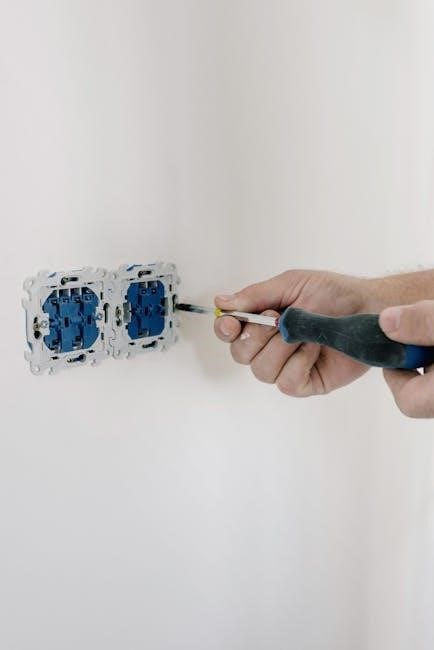Planning and Preparation
Planning and preparation are crucial for a successful carport installation. Assess the site, ensuring it’s level and clear of debris. Measure the area carefully to fit your carport size. Check local building codes and obtain necessary permits to avoid legal issues. Create a detailed layout plan, marking corners and center points for accurate assembly. Ensure all tools and materials are ready before starting the project.
1.1. Site Preparation and Layout
Site preparation is essential for a smooth carport installation. Clear the area of debris, vegetation, and obstructions to ensure a clean workspace. Check for underground utilities and mark their locations to avoid damage. Level the ground thoroughly, as uneven terrain can compromise stability. Use stakes and string to mark the carport’s perimeter and center points, ensuring proper alignment. Verify the site layout matches your plans and local building codes. A well-prepared site ensures accurate assembly and prevents future structural issues.

1.2. Choosing the Right Carport Size and Design
Choosing the right carport size and design is vital for functionality and aesthetics. Measure your vehicle to determine the minimum width and height required. Consider additional space for future needs or extra storage. Select a design that complements your property, such as gabled, flat, or A-frame styles. Metal carports are durable and low-maintenance, while wooden designs offer a more traditional look. Ensure the design aligns with local building codes and your budget. A well-chosen carport size and design ensures proper protection for your vehicle and enhances your property’s curb appeal.
1.3. Understanding Local Building Codes and Permits
Understanding local building codes and permits is essential before starting your carport installation. Research your area’s regulations to ensure compliance with structural and safety standards. Obtain necessary permits to avoid legal issues or fines. Building codes may dictate height, setback, and material requirements. Verify if your carport design meets wind, snow, and seismic load standards. Contact local authorities to confirm permit requirements and inspections. Non-compliance can lead to project delays or removal. Ensure all documentation is complete before construction begins to avoid complications.
Gathering Tools and Materials

Gather essential tools and materials before starting the installation. Ensure you have all necessary components organized and readily available to streamline the process efficiently.
2.1. Essential Tools for Carport Installation
Having the right tools is critical for a smooth carport installation. Key tools include a wrench, screwdriver, drill, hammer, measuring tape, level, saw, ladder, and safety gear like gloves and goggles. Use a torque wrench for securing bolts tightly, and ensure all tools are in good working condition. A level is essential for ensuring the structure remains straight and plumb. Organize tools beforehand to avoid delays during assembly. Refer to the manufacturer’s instructions for specific tools recommended for your carport kit. Proper tools ensure accuracy and safety throughout the installation process.
2.2. Required Materials and Hardware
Ensure you have all necessary materials and hardware for your carport installation. Typical materials include pre-cut steel or metal frames, roofing panels, support beams, and wall siding if needed. Hardware includes bolts, screws, washers, and anchors for securing the structure to the ground. Weather-resistant fasteners are essential to prevent rust and ensure durability. Sealants and flashing may be required for roof panel connections. Double-check the manufacturer’s list for specific materials included in your carport kit. Having all components ready ensures a smooth and efficient installation process, avoiding delays caused by missing items.
Foundation and Base Installation
Prepare the ground by leveling and compacting it to ensure a stable base. Install anchors or footings as specified in your carport kit instructions. Secure the base firmly to prevent shifting or settling, ensuring a solid foundation for the structure. Follow manufacturer guidelines for anchor placement and depth to guarantee safety and durability.

3.1. Preparing the Ground for a Stable Base
Start by clearing the installation area of debris, vegetation, and obstructions. Ensure the ground is level and even, as uneven terrain can compromise the carport’s stability. Compact the soil or gravel base to create a firm surface. Mark the corners and center of the carport location using stakes and string for precise alignment. If necessary, excavate the ground to the recommended depth for the foundation type specified in your carport kit. Lay down a weed barrier to prevent plant growth under the structure. Finally, ensure proper drainage to avoid water pooling, which could weaken the base over time.
3.2. Installing Anchors and Footings
Begin by marking the locations for anchors according to your carport layout plan. Dig holes to the required depth for each anchor, ensuring they align with the carport’s frame. Place anchor kits or footings into the holes, securing them with concrete. Pour the concrete mixture into the holes, filling them completely. Use a level and plumb line to ensure the anchors are straight and properly aligned. Allow the concrete to set fully before proceeding. This step ensures a secure and stable base for your carport, preventing shifting or structural issues over time.

Assembling the Carport Frame
Start by attaching side rails to the base, then align and secure the support beams with bolts for stability. Pre-drilled holes simplify the process, ensuring proper alignment and a sturdy frame. Follow manufacturer instructions for the correct sequence and tighten all connections to maintain structural integrity.
4.1. Erecting the Main Support Beams
Begin by unpacking and identifying the main support beams, ensuring they match your carport design. Position the beams according to the pre-determined layout, aligning them with the anchor points. Use the anchor kits provided to secure the beams to the ground or concrete foundation. Tighten the bolts firmly to ensure stability. Double-check that the beams are level and plumb using a spirit level. If necessary, use shims to adjust for uneven ground. Once aligned, use lag bolts for concrete or anchor rods for ground installation. Ensure all connections are secure and the structure stands upright before proceeding. Safety first—use temporary supports if needed.
4.2. Attaching the Roof Support System
After erecting the main beams, focus on attaching the roof support system. Unpack the roof rafters and purlins, ensuring all components are included. Position the rafters evenly across the top of the main beams, securing them with bolts or screws. Install purlins between the rafters to provide additional support for the roofing material. Use the provided hardware, such as lag bolts or self-tapping screws, to ensure a tight connection. Double-check that the roof support system is level and properly aligned with the main beams. Tighten all connections firmly and verify that the structure can withstand weight and weather conditions. Use temporary bracing if needed for stability during assembly.
Installing Roofing and Siding
Secure roof panels tightly to the support system, ensuring proper alignment and weatherproofing. Attach siding to the frame for added protection and visual appeal. Use durable materials like galvanized steel for longevity and resistance to harsh weather conditions. Follow manufacturer instructions for precise fitting and finishing touches.
5.1. Securing the Roof Panels
Begin by aligning the roof panels with the frame, ensuring proper fitment and orientation. Use the provided hardware to fasten panels securely, starting from the center and working outward. Tighten all bolts evenly to maintain structural integrity and prevent warping. Apply weatherproofing seals around edges and overlaps to ensure a watertight finish. Double-check panel alignment and fastening torque to meet manufacturer specifications. This step is critical for durability and weather resistance, ensuring your carport withstands harsh conditions effectively.
5.2. Adding Siding for Protection and Aesthetics
Install siding panels to the carport frame for enhanced protection and visual appeal. Start by attaching the bottom panel, ensuring it aligns with the frame’s base. Secure each subsequent panel by overlapping edges and fastening with provided screws. Use weather-resistant fasteners to prevent rust and corrosion. Leave a small gap at the top for ventilation. Trim excess material with a saw or utility knife for a clean finish. Siding not only shields the structure from elements but also complements the surrounding architecture, boosting curb appeal and long-term durability.
Final Inspection and Touch-ups
Conduct a thorough inspection of the carport, checking for loose bolts, uneven panels, and gaps. Tighten all hardware and ensure the structure is level. Apply touch-ups to any scratched or exposed metal surfaces for a polished finish. Verify that all components are securely fastened and the carport is safe for use. Address any issues promptly to ensure durability and longevity of the structure.

6.1. Checking for Structural Integrity

Begin by ensuring the carport is level and plumb, verifying that all columns and beams are upright. Inspect for any signs of sagging or unevenness in the roof and rafters. Check that all bolts, screws, and fasteners are securely tightened and not loose. Examine the roof panels for proper alignment and ensure they are firmly attached to the frame. Look for any gaps or misaligned connections that could compromise stability. Verify that the structure can withstand wind and snow loads as specified in the design. Address any issues immediately to maintain the carport’s structural integrity and safety.
6.2. Tightening Loose Bolts and Hardware
After completing the structural inspection, examine all bolts, screws, and hardware for tightness. Use a wrench or socket to ensure every connection is secure. Pay particular attention to roof support beams, corner brackets, and anchor points. Tighten any loose fasteners firmly but avoid over-tightening, which could damage the material. Double-check all joints and connections to ensure stability. For larger carports, consider applying torque wrench settings as specified in the manufacturer’s guidelines. Finally, perform a thorough walk-through to confirm all hardware is properly secured and the structure remains stable and safe.